The piece of the month of October 2020
SAINTS CRISPIN AND CRISPINIANUS IN THE CHURCH OF SAN LORENZO, PAMPLONA
José Luis Molins Mugueta
Chair of Navarrese Heritage and Art
Saints Crispin and Crispinianus: religious and cultural life and influence
There is documentary evidence of the worship of the saints Crispin and Crispiniano in the parish church of San Lorenzo, as patrons of the confraternity of the same name, approved in 1430, which brought together the master builders of Pamplona. There was another for the same purpose in San Nicolás, under the patronage of Saint Eloy. Both had their altar and altarpiece in their respective churches. There are also references to an eponymous association in the Navarrese town of Los Arcos, created in the second half of the 18th century. The peculiar name was applied to the new shoemakers, but not to the old cobblers, a fact that allowed Mesonero Romanos to write a certain verse...
To the glorious St. Crispin
protector of the work prima,
solemn worship services
his devout confraternity.
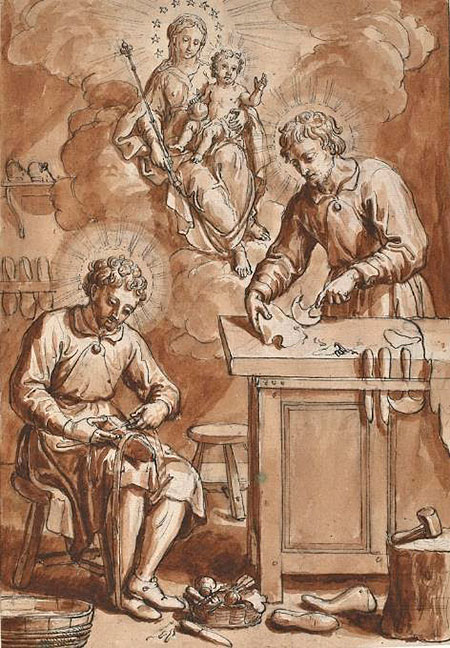
Saint Crispin and Saint Crispinian. Wash, pencil and black ink on paper,
17th century, Museo del Prado.
Brothers in faith, and perhaps in blood, Crispinus and Crispinianus, who have been celebrated for centuries by the Church of France, fled from their native Rome in the middle of the 3rd century because of the persecutions. They went to Gaul and settled in Soissons. There for several years, day after day, they proclaimed Jesus Christ and at night they worked as shoemakers to earn their living, although they repaired the shoes of the needy free of charge. Their preaching, backed up by the holiness of their conduct, converted a considerable issue of pagans, until, on the occasion of the visit to Belgian Gaul of Maximian, co-emperor with Diocletian, they were denounced, martyred and beheaded, perhaps between 287 and 290, with the important regional official Rictius Varus being involved in the double murder. Although the account of their passio is not reliable, their real existence seems certain: apart from being included in the Martyrologies of St. Jerome, Bede, Florus Deaconus, Adon of Vienna and Usuardo, the testimony of Gregory of Tours, who mentions an old basilica in Soissons erected to the report of both martyrs, still standing and with the continuation of their cult in the 6th century, is unquestionable.
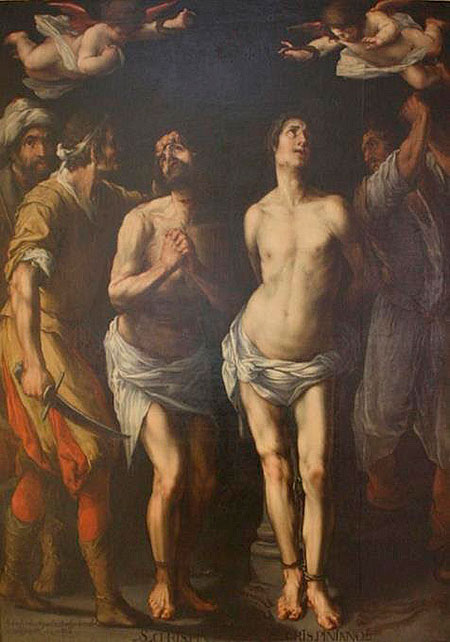
Sebastián Martínez Domedel. Martyrdom of Saint Crispin and Saint Crispiniano (c. 1638). Episcopal Palace of Jaén.
Perhaps because of their work with leather, on some occasions and in different places they have been elected patrons of tanners' guilds. In France, their memory is still relevant, at least culturally, so that it is common to visit cathedrals and churches and find recent stained glass windows dedicated to Saints Crispin and Crispinianus.
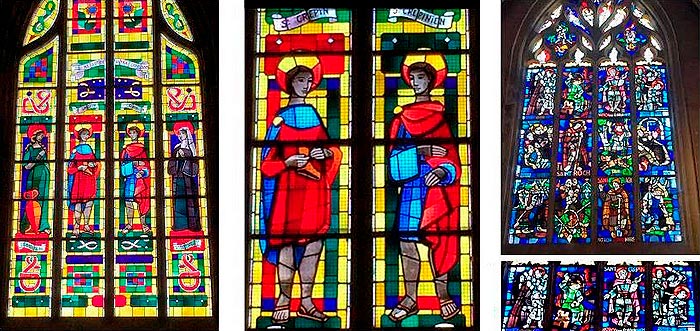
On the left, in the church of Saint-Leonard in Fougères (France), stained glass window by François Lorin showing Saints Crispin and Crispinianus (1959). On the right, stained glass window and detail with scenes of the same motif in the Basilica of Saint Saviour in Dinan (France). Work of Louis Barillet's workshop, between 1939 and 1951.
Martyred saints occupy a place in English literature, and thus in world literature, thanks to Shakespeare. In The Life of King Henry V (Act IV, Scene III), as the action approaches the battle of Agincourt or Azincourt, which took place on 25 October 1415, the feast of St Crispin and St Crispinianus, the British playwright puts a moving speech of encouragement in which he invokes the former six times and the latter once 1. workshop The battle of Agincourt was a decisive one for the English arms, as it was a milestone in the course of the Hundred Years' War, marking an important victory for his army, which was much smaller in issue, over the heavy French feudal cavalry of Charles VI.
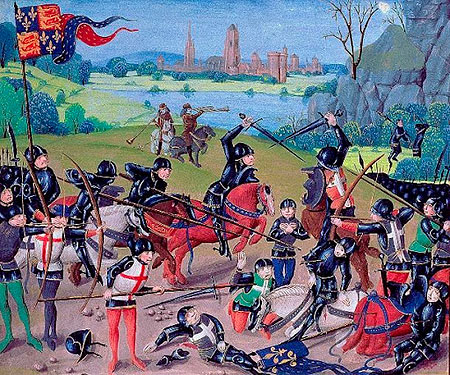
Battle of Agincourt. Chronicle of St. Albans, by Thomas Walsingham. c. 1422. Bibl. Pal. Lambeth (Wikimedia Commons).
In Pamplona
Shoemakers had a relatively large presence in Pamplona, as can be seen in the two confraternities, one sponsored by San Eloy, located in the parish of San Nicolás, and the other, under the patronage of the saints Crispín and Crispiniano, in the parish of San Lorenzo. In 1757, it was necessary to modify the ordinances to limit the number of shoe-making workshops in the city. José Joaquín Arazuri, when review in Pamplona. The streets and neighbourhoods of "Curtidores" as a group of old houses, some of them in ruins, on the left bank of the Arga, downstream from the Rochapea bridge and under the Portal Nuevo, indicates the name of what was popularly known as the "Casa de los maestros de obra prima" (House of the master shoemakers). Tanners and shoemakers had a clear professional interdependence, which explains the existence of a storeroom for hides and skins that the shoemakers' corporation owned on the land of the current Taconera, for the convenience of its members, who thus avoided going down to the riverbank.
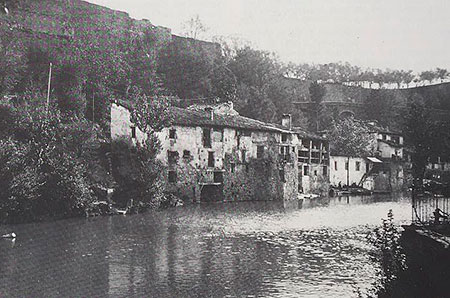
Tanneries in the Curtidores district (1931-1934).
The industrialisation of the 19th century, especially in its second half with the introduction of sewing machines and other types of machines, soon made the shoemaking profession economically unsustainable; although in 1917 the press can still read review about the celebration of the festival that the shoemakers' guild dedicated on Thursday 25th October in honour of their patrons Saint Crispin and Saint Crispiniano, in the usual way: with a well-attended religious celebration and the obligatory excursion to the countryside, which was favoured by "truly splendid" weather.
San Lorenzo Parish Church: its images
Published in 1974, in a monograph focusing on the study of the Chapel of San Fermín, I alluded to the images of Saint Crispin and Saint Crispiniano, located on either side of the entrance frontispiece, as being Baroque in style, originally belonging to the first frontispiece, inaugurated together with its area in 1717 and integrated into the new academic façade, due to the reform designed by Santos Ángel Ochandátegui, carried out between 1800 and 1805. I was partly right and partly wrong. Located at a certain height and made up as if they were made of stone or plaster, it seemed to me that they could have formed part of the first façade and that, out of devotion, they were rescued for reuse. I considered them to be baroque, with Mannerist reminiscences, and that the folds in the arrises showed the influence of Gregorio Fernández: up to this point, I can confirm my opinion. But their origin can be explained in another way.
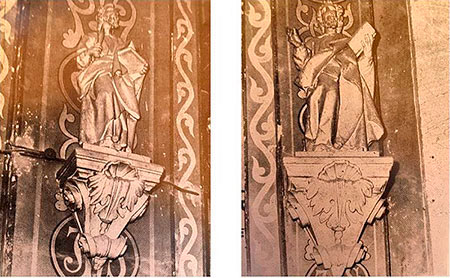
Saint Crispin and Saint Crispinianus at the front of the Chapel of San Fermin.
The authors of the Catalog Monumental de Navarra. Merindad de Pamplona, in the place corresponding to the parish church of San Lorenzo, point out, positioned with others on the side corresponding to the Gospel, the altarpiece of San Crispín and San Crispiniano, commissioned around 1649 by the shoemakers' guild to García de Peruzurguín, which by 1650 was finished. This circumstance made possible the order of its gilding and polychromy to the master painter Joan de Ibáñez, in the amount of 150 ducats. Ibáñez was to paint in oil on the pedestal panels the martyrdoms of both saints, while on the four panels of the columns the entire images of the Evangelists would appear. On the other hand, the carvings of the saints were to be gilded, estofado and sgraffito. García de Peruzurguín, architect of altarpieces, was the son of the assembler Miguel de Peruzurguín, both natives of Arbizu. García had a long lawsuit from 1660 against the vicar of Villanueva de Araquil, trying to collect payment for the main altarpiece and doors of that church. His ailing widow, Magdalena de Elola, also from Arbizu, continued the claim in 1679, empowering her son Francisco de Peruzurguín, presbyter, as legal representative. But payment was not obtained until April 1723, with other protagonists.
In 1881, the Obrería was extinguished and the new board de Fábrica de San Lorenzo began to carry out its functions, with the mediation of submission and receipt of the opportune inventory. It states that the church had ten altars, four of which were privately owned: one of the latter, the altar of Saint Crispin and Saint Crispiniano, belonged to the brotherhood of shoemakers. The dismantling of this altarpiece, or what was left of it, probably took place on the occasion of the major works undertaken by the parish priest Marcelo Celayeta between 1906 and 1908. Perhaps it was then that the images of our present interest were placed in the frontispiece of the Chapel of San Fermín, where they were until the mid-1970s and where we have known them; first in the atrium of the parish church, later in the sacristy, and finally, with a surprising transmutation into the holy apostles Peter and Paul, with a return to the niches of the entrance.
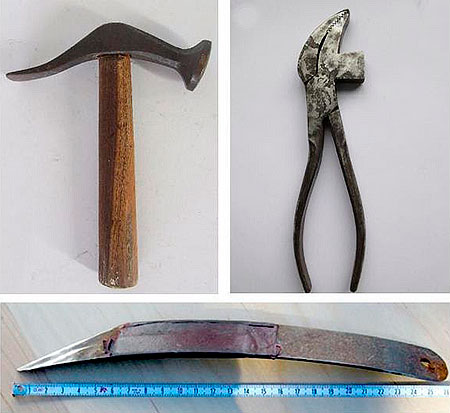
Old shoemaker's tools.
The iconography of Crispinus and Crispinianus has been expressed in different ways. As martyrs, in some cases they bear the palms of martyrdom; as preachers of the Gospel, they may hold the book in their hands; as master shoemakers, they hold the tools of official document: the pin, the pincer, the hammer... There is no shortage of pictorial or relief scenes in which they are depicted making shoes indoors, comforted by the image or apparition of the Virgin and Child. In the case of Pamplona, we met them with a book in their left hand and at least one, who I suppose to be Crispín, with a hammer in his right hand. It would be a good idea to help them to recover their Christian and historical-artistic personality by means of a suitable technical restoration.
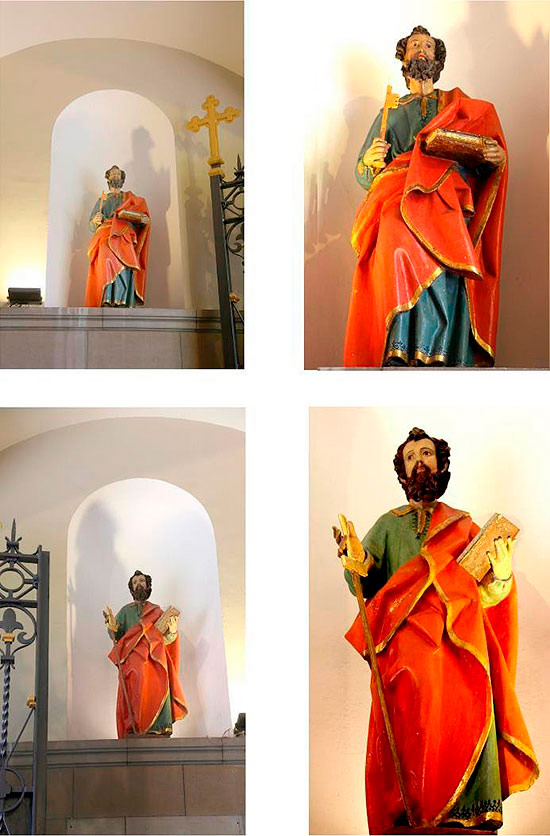
St. Crispinianus, qualified as St. Peter, and St. Crispinianus, as St. Paul.
1 King Henry, on the eve of the battle of Agincourt: "This day is the feast of Saint Crispin; he who survives this day will return safe and sound to his homeland, will stand on his toes when this date is mentioned, and will rise above himself at the name of Saint Crispin. Whoever survives this day and reaches old age, every year on the eve of this feast will invite his friends and say to them: "Tomorrow is St. Crispin's Day". Then he will roll up his sleeves, and, showing his scars, he will say: "I received these wounds on St. Crispin's Day". Old men forget; but he who has forgotten all, will still remember with satisfaction the exploits he performed on that day.... The good man will tell this story to his son, and from this day to the end of the world the feast of St. Crispin and Crispiniano will never come without our memory, the memory of our little army, of our happy little army, of our band of brothers; for he who sheds his blood with me today will be my brother; however vile he may be, this workshop will ennoble his condition, and the knights who now lie in the bed of England will think themselves accursed that they were not here, and will have their nobility at a low price when they hear one of those who have fought with us on St. Crispin's Day.
BIBLIOGRAPHY
ARAZURI, José Joaquín, Pamplona. Streets and neighbourhoods. A-D, Pamplona, Castuera, 1979.
ARIAS DE SAAVEDRA, Inmaculada and LÓPEZ MUÑOZ, Miguel Luis, "Cofradías y gremios de Navarra en la época de Carlos III", Hispania Sacra, vol. 50, no. 102, 1998, pp. 667-695.
GARCÍA-GAINZA, María Concepción et al., Catalog Monumental de Navarra. V***. Merindad de Pamplona. Pamplona: Government of Navarre-Archbishopric of Pamplona-University of Navarre, 1997.
LEONARDI, C., RICARDI, A. and ZARRI, G., Diccionario de los Santos. Madrid: San Pablo, 2000.
MARTINENA RUIZ, Juan José, "La reedificación neoclásica de la Iglesia de San Lorenzo de Pamplona", Príncipe de Viana, Pamplona, Government of Navarre, 1981, pp. 385-478.
MOLINS MUGUETA, José Luis, Capilla de San Fermín en la iglesia de San Lorenzo de Pamplona, Pamplona, Diputación Foral de Navarra-CSIC-Ayuntamiento de Pamplona, 1974.
PÉREZ SÁNCHEZ, Alfonso E., Catalog of drawings. I. Spanish drawings of the XV-XVI-XVII centuries, Museo del Prado, 1972.
SALES TIRAPU, José Luis and URSÚA IRIGOYEN, Isidoro, Catalog del file Diocesano de Pamplona. Processes Section, Pamplona, Government of Navarra, 1995.
SHAKESPEARE, William, The Life of King Henry V, Madrid, Aguilar, 1993.
